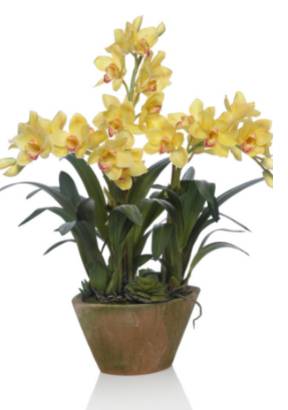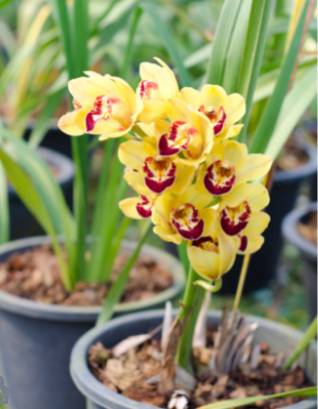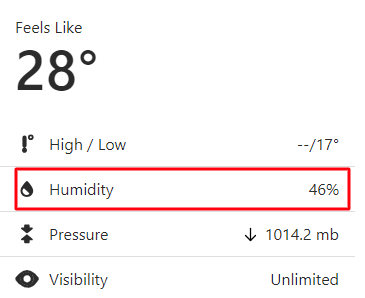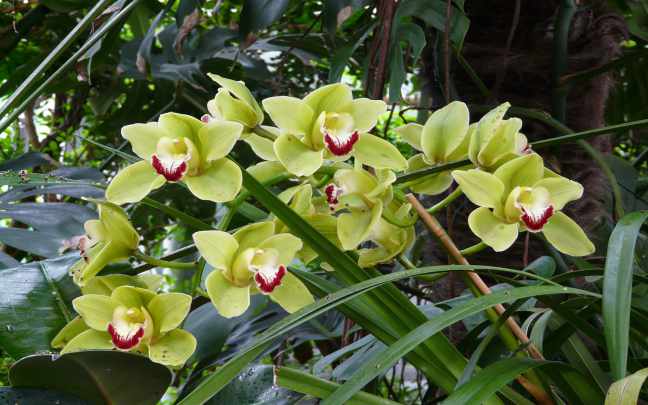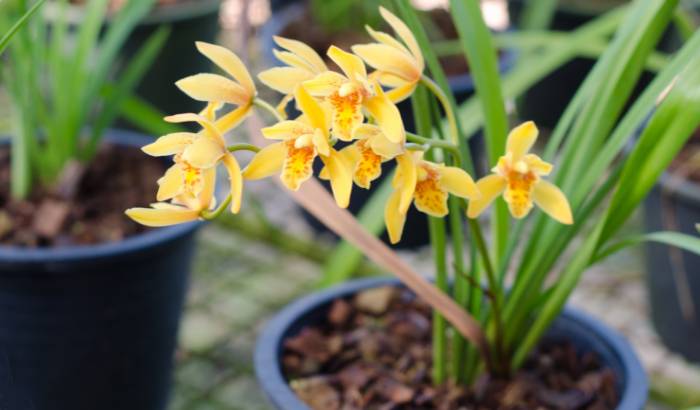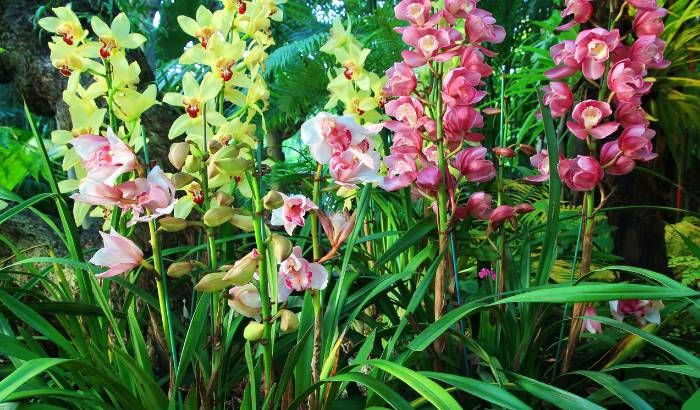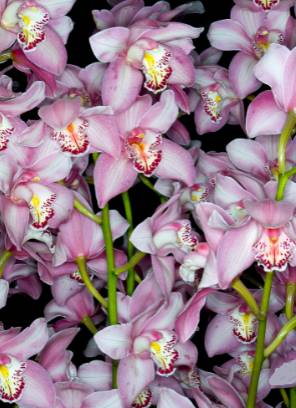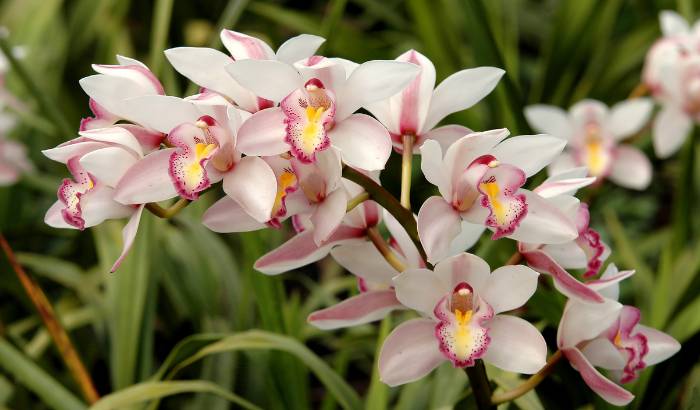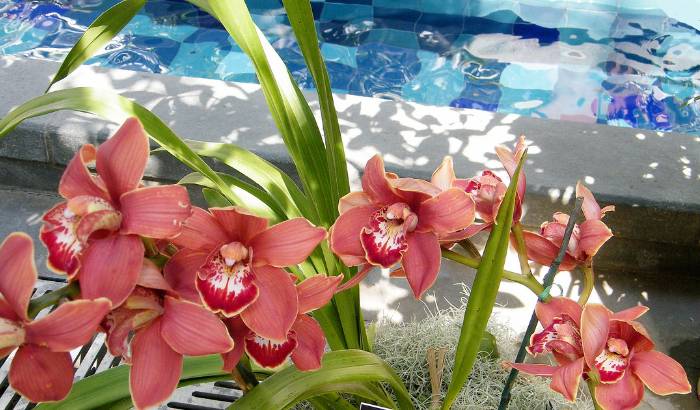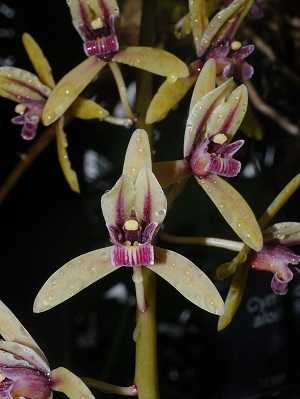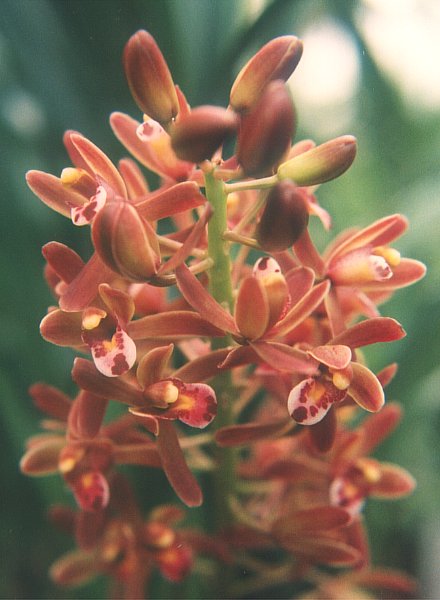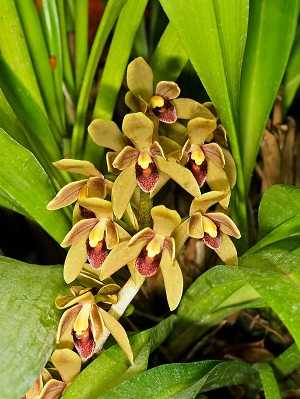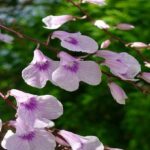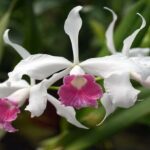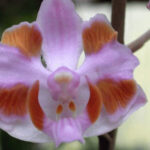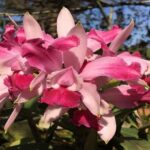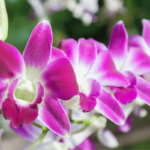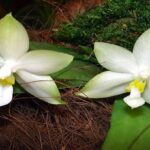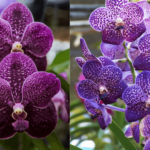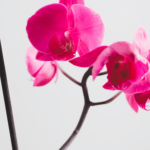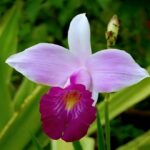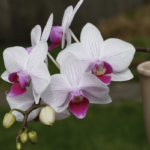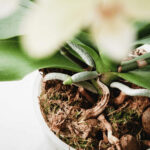The orchid genus Cymbidium currently comprises 69 species and can be considered one of the most famous and admired by orchid enthusiasts.
It is native to the following countries:
- Australia
- China
- India
- Sri Lanka
- Malaysia
- Japan
- Philippines
- Nepal
- Vietnam.
Discovered in 1799 by Olof Swarts, it has been hybridized by humans for over 100 years.
It is estimated that today, there are more than 11,000 Cymbidium hybrids spread around the world.
Also known as Boat orchid, Cymbidiums can be epiphytic (grow on trees) or terrestrial (grow in the soil).
They use their roots to absorb water and nutrients and to attach themselves to trees or other surfaces.
Want to learn more about this orchid?
Then keep reading this article.
Learn How to Achieve Super Blooms on Your Orchids
🛑 If you love orchids and you're tired of not being able to make them bloom...
Then, know that thousands of beginner growers are achieving beautiful flowers on their orchids by following this method.
Click the button below to have beautiful orchids with show-worthy flowers every year. ⤵
How to Care for Cymbidium Orchids
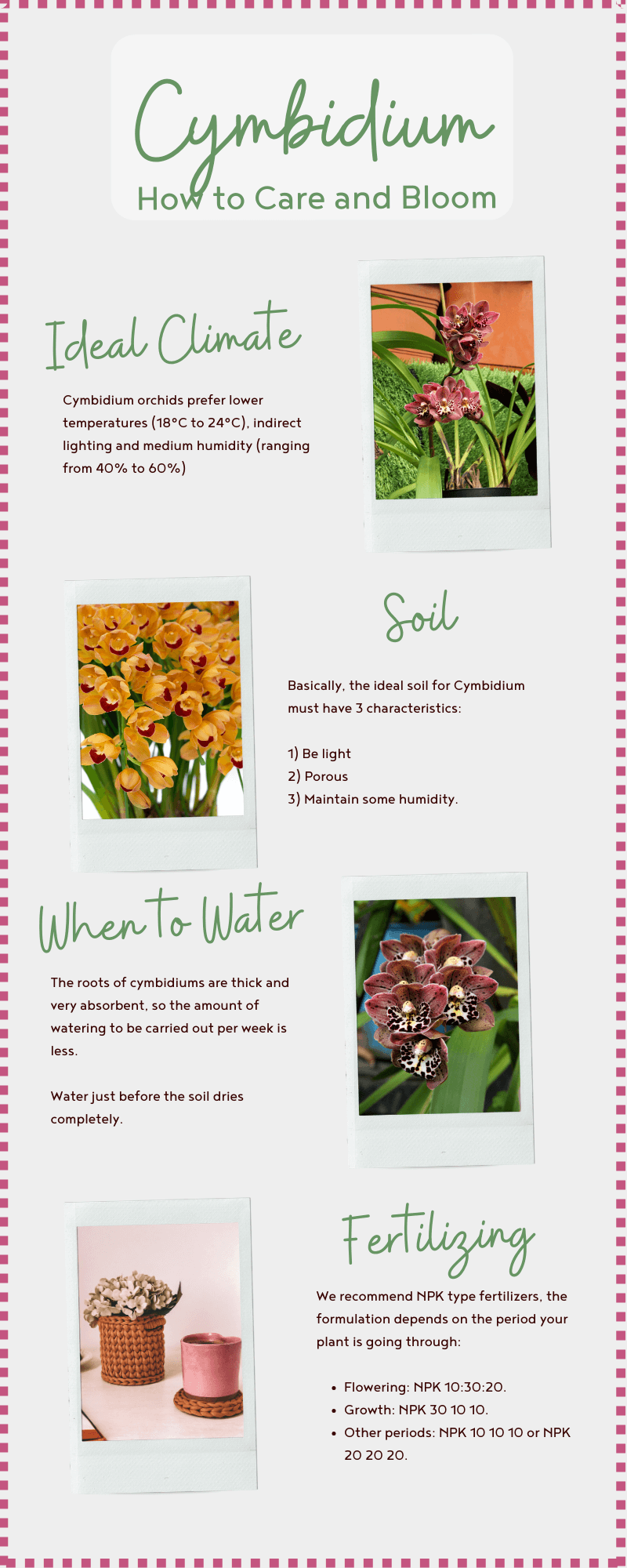
To care for Cymbidium orchids, you need to provide the following requirements:
- Lower temperature
- Plenty of indirect sunlight
- Moderate humidity
- Good ventilation
- Substrates that retain moisture
- Watering at the right time
- Using the correct fertilizers for each phase.
- Terracotta pot
- Repotting every 2 or 3 years
Below, we will delve deeper into each of these requirements.
However, cultivating Cymbidium orchids can be challenging, depending on the climate.
Because it is a plant that prefers cold or mild climates and does not adapt well to warmer climates.
So if you live in warmer areas, avoid buying a boat orchid.
1 – Temperature Care
The ideal temperature is very important for Cymbidium.
They are much more resistant to cold than other orchids.
Because they can withstand very low temperatures for a short period of time.
Ideal temperature for Cymbidium:
- Between 18ºC and 24ºC (64.5°F and 75°F) during the day.
- During the night, it should decrease to 10ºC to 16ºC (50°F to 61°F).
Ensure there is a difference of at least -7ºC (44,6 °F) in temperature from day to night.
To achieve this temperature drop at night, some techniques are recommended:
- Expose it to the open sky to feel the cold of the night.
- Water it with ice or cold water at night, avoiding contact with the bulbs.
Cymbidium orchids can survive lower temperatures; they just need to be protected from frosts and rains.
2 – Luminosity
Now that you have taken the necessary precautions with your plant’s temperature, let’s focus a bit more on luminosity.
Remember that temperature and luminosity are very different.
Ideal luminosity occurs when you place the plant in indirect sunlight or under shading nets.
This way, you prevent the leaves from burning.
To check if your plant is receiving the right amount of light, check the color of its leaves:
- If the leaf is very light green, almost yellow, it is receiving too much sun.
- If it is dark green, it needs more sun.
3 – Humidity
Humidity is one of the biggest challenges you will face when growing your orchids.
This happens because few people are willing to invest in a device to measure air humidity.
But fortunately, there is an easier way to do this, which is through the internet.
Access the website weather.com and search for your city.
Then you will see an image like this:
Now, just check today’s humidity.
As for Cymbidium orchids, the ideal humidity is 40% to 60%.
NOTE: you can increase humidity by placing a container of water near your orchid, but not under it.
Remember that good air circulation is also essential for your orchid’s health.
4 – Ideal Substrate
Boat orchids, like most orchids, need substrates to thrive.
For those growing their cymbidium in pots, it is recommended to use a mixture for epiphytic plants with sterilized humus and river sand.
Basically, the ideal substrate for boat orchid should have 3 characteristics:
- Lightweight
- Porous
- Retains some moisture.
Therefore, the substrates I recommend are:
- Clay
- Rounded pebbles
- Pine bark
- Coconut fiber
- Gravel
- Charcoal
- Tree fern fiber
If you choose to use fine orchid bark, note that it is more suitable for cymbidiums smaller than 15 cm (5,9 inch).
The coarse orchid bark is recommended for cymbidiums larger than 15 cm (5,9 inch).
5 – Watering
This is the factor I worry about the most when it comes to caring for orchids: watering.
This is because excess watering can cause various diseases and potentially kill your orchid.
And if you don’t water it, it will weaken.
If you go for long periods without watering, they can go up to 2 years without blooming or may die.
So first, let’s go over some basic tips.
- Type of water: If possible, use rainwater to water your orchid. Also, remember to water it with lukewarm water.
- How often to water per week: boat orchids have thick and very absorbent roots, so the number of waterings per week is lower.
So be very careful not to overdo it and harm your plant.
To prevent this, let’s delve deeper into when to water your orchid.
To have a successful watering, you should follow the rules below:
- Water more frequently during the warmer months. Because the humidity will be lower, and the temperature higher, increasing water evaporation.
- When the pseudobulbs stop growing, you should reduce watering. The growth period is over, so it doesn’t need as much water anymore.
- Water when the substrate is almost dry. To check this, simply insert your finger a few centimeters (1 inch) into the substrate and see if it’s still wet. If yes, wait 1 day and check again. If it’s almost dry, water your orchid.
Normally, the watering period in summer is 2 to 3 times a week, and in winter, it’s once a week.
But as mentioned earlier, this depends on various factors, so it’s best to determine the best period for your Cymbidium.
Now, some tips for watering your cymbidium during flowering:
- Avoid wetting the flowers: If the flower gets wet, it can become infected or attacked by diseases. Therefore, only water the leaves and roots.
- Avoid letting your orchid completely dry out: Cymbidiums don’t like that. They should be kept moist, but never soaked.
- Water generously
6 – Fertilization
Despite being a very simple fertilization process, it can be tricky, and if done incorrectly, can harm your orchid.
As mentioned earlier:
Lack or excess of fertilizers can affect flowering, and this is a very common mistake.
But there is another danger.
Do not fertilize your orchid if it is dry, as the fertilizer can burn its roots and leaves.
This will greatly harm your plant.
Therefore, before fertilizing, check if your plant is wet/moist (not waterlogged).
Do You Want to Learn How To Keep Your Orchids Healthy And Ready to Bloom Every Year?
So, I prepared a complete guide, step by step and illustrated, that will show you:
• The secrets to getting beautiful flowers every year
• How to fight and identify pests and diseases on your orchids
• THE MAGIC SUBSTANCE for orchids and how to use it
• And much, much more.
The great news is that the manual is now available at a super discount!!
But beware, it's only for the first buyers.
Click on MORE INFORMATION below and discover the secrets to show-worthy flowers. 👇
How to Fertilize The Boat Orchid
Now let’s talk more about fertilizing the cymbidium orchid.
It is an orchid that needs more fertilizer than most other species, but be careful not to overdo it.
One tip that can help provide nutrients for your orchid is not to discard dry bulbs, as they have valuable nutrients for boat orchid.
If you are a beginner, know that there are two main types of fertilization: organic or natural and inorganic or chemical.
Basically, organic fertilization uses natural sources to nourish the plant, and inorganic fertilization uses sources produced by humans.
Usually, inorganic fertilization is easier and more effective for orchids, but there are also precautions you should take during fertilization with them.
What Fertilizer to Use
Organic fertilizers, such as bone meal and castor meal, can be used to fertilize cymbidium orchids.
In inorganic fertilization, you will basically find fertilizers known by the NPK formula.
This formula represents the three main nutrients that most plants need for their development.
- N – Nitrogen
- P – Phosphorus
- K – Potassium
For cymbidium, there are several fertilizer formulations that can be used for its proper development.
It’s better to use each one during a phase of the orchid.
- During flowering, cymbidium orchids need more phosphorus, so a fertilizer with a high phosphorus content, such as NPK 10:30:20, is recommended.
- Growth: It’s necessary to increase the amount of nitrogen, making the ideal formulation NPK 30 10 10.
- Other periods: It’s recommended to use a more balanced formula, such as NPK 10 10 10 or NPK 20 20 20.
In both cases, fertilize every 2 weeks.
When choosing fertilizer, don’t forget that it should be able to dissolve in water; this is one of the basic requirements for orchid fertilizers.
When preparing the fertilizer solution, use half the amount of fertilizer that is recommended on the package.
For example, if the package says one teaspoon for 2 liters of water, use one teaspoon for 4 liters.
7 – Ventilation
Lastly, let’s talk about ventilation.
This is the easiest factor and can also be considered useful for all types of orchids.
All orchids require moderate airflow and temperature.
Also Read:
- Vanda Orchid – How to Care, Plant, and Bloom
- Black Orchid – Types, Curiosities, and Photos
- 12 Rare Orchids You’ve Never Heard Of
- Monkey Face Orchid – Photos, Curiosities, and More
- Ballerina Orchid – See Its Photos, Curiosities, and More
8 – Pests and Diseases
When well-cultivated, cymbidium is very resistant to pests and diseases. However, cymbidium orchids can still be susceptible to pests and diseases, so it is important to take preventive measures.
One of the most common pests in boat orchid is the red spider mite.
Fortunately, it can be easily avoided because it will only attack your plant if it is in a dry atmosphere.
So the only care needed is with the humidity of your environment.
Some other problems your plant might have been:
- Other types of mites (can be avoided with well-nourished plants and well-ventilated places)
- Aphids and mealybugs insects
- Bacteria and fungi (don’t place them in very bad conditions: excessive moisture, too dark or bright, bad substrate)
9 – Pot
It is essential to choose the right pot for your cymbidium.
This is because a good pot can greatly facilitate its cultivation.
Additionally, it will make your orchid look more vibrant and have more beautiful flowers.
The basic requirements that every pot must have for a cymbidium are as follows:
- Good drainage
- Proper water drainage
- Small and tall
Terracotta pots are a good choice for cymbidium orchids because they drain well.
Ensure that it is tight for your cymbidium, as they thrive in tight pots.
This is because they are often better than plastic pots.
10 – Planting and Repotting
Repotting is extremely necessary for your orchid to be well-cultivated.
There are several reasons why you need to learn how to repot boat orchid, some of these are:
- As your plant grows, the pot becomes tighter
- Over time, the substrates become old
Normally, cymbidium orchids need repotting approximately every 2 to 3 years.
When your orchid becomes too large, it will start to outgrow the pot or become very awkward in it.
And the substrate, when old, either retains excess water or cannot retain water properly.
If the pot is too small or the substrate is old, you can either repot the orchid into a larger pot or divide the plant.
Remember that the best time to repot an orchid is 2 to 3 weeks after flowering.
11 – How to Plant
To plant a cymbidium orchid, do the same thing as when repotting, except that you do not need to remove the orchid from another pot.
You can plant cymbidium orchids in the following places:
- Trees
- Logs
- Pots
- In the ground
To plant boat orchid in the ground, you should know the following.
In some species, you can plant them in the ground, but not all.
Cymbidium orchids are either epiphytic or terrestrial, and only those that are terrestrial can be planted in the ground.
It is generally easier to care for cymbidium orchids in pots than in the ground.
How to Care for Hanging Cymbidium
Hanging cymbidiums are those cymbidium species that have their flower spikes cascading downward.
The great advantage of these orchids over others is that they bloom more easily and produce more flowers.
Caring for hanging cymbidiums is very similar to caring for others, making them considered relatively easy to cultivate plants.
How to Make Cymbidium Orchids Bloom
Before we talk about the characteristics of cymbidium flowers, you should know what might be hindering your orchid from blooming.
Understanding this issue deeply will help you encourage your boat orchid to bloom.
Temperature
Cymbidium orchids need cooler temperatures to bloom, so they are not well-suited to warmer climates.
Another problem is temperature variation.
Cymbidium orchids require a temperature drop at night to bloom.
This temperature drop will trigger the development of flower spikes.
For best flowering, the temperature should drop by an average of 10 degrees Fahrenheit (5.5 degrees Celsius) at night.
Location and Lighting
If the buds are falling off before they open, it might be a sign that you moved your orchid.
This happens because most orchids don’t like to be relocated, and in the case of boat orchids, it can hinder flowering.
Therefore, choose the best spot for your orchid and move it as little as possible.
Another mistake is lighting.
Often, orchids have their flowering interrupted when they don’t receive the ideal amount of light.
This can happen both in low light and in high light.
- Insufficient light may prevent the flowers from emerging.
- Excessive light can burn the leaves and suppress flowering.
Below, we will discuss the ideal temperature and lighting conditions for your cymbidium orchid.
Watering and Fertilization
Another item that can affect your orchid could be the water used during watering.
If it has a high salt content, the plant’s leaves will fall, the tips will turn black, and your orchid may die.
If it’s not any of these factors that are hindering your orchid’s flowering, it could be this last one: incorrect fertilization.
Your orchid might need nutrients to bloom or might be overwhelmed with excess fertilizer. In both cases, flowering will be severely affected.
Natural Reasons
These were the reasons your cymbidium orchid might not be flowering due to cultivation mistakes.
But there are also some natural reasons for your cymbidium not to flower for a certain period, which include:
- It may not flower for 6 months to 1 year after repotting.
- It’s too young.
Now that you know the possible reasons that can prevent your boat orchid from flowering, let’s look at some characteristics of its flowers.
How to Improve Flowering
Now that you’ve learned how to take care of cymbidium orchids, let’s delve into some slightly advanced techniques.
With these techniques, you will achieve better flowering results and ensure better health for your plant.
Cymbidium Flower Spike
When your spikes/clusters are well-formed, it’s recommended to provide them with a stake.
In other words, take a bamboo stick or some other stake and tie them to prevent the spikes from breaking during their development.
They should remain upright.
After use, do not reuse the wooden stakes, as they can transmit diseases to other orchids.
Now that you know:
- What might be preventing your cymbidium orchid from flowering
- The characteristics of the flowers
- How to use a stake for your spike
Let’s learn what to do with your cymbidium’s keikis (pups).
Care for Keikis
The appearance of keikis in your orchid is a great sign for flowering.
After the first keikis appear, your long-awaited flowers will bloom in about 4 to 6 months.
This also means it’s not time to repot your orchid.
Now, you must be careful if too many keikis appear, as they can hinder flowering. Excessive keikis affect flowering, and if this happens, break some of them to avoid putting too much stress on your orchid.
Should I Trim the Cymbidium?
After flowering, you need to take some precautions to ensure a new flowering next year. So, right after flowering, remove the dead flowers and leaves.
As for old pseudobulbs, leave them until they dry out.
Even if they don’t contribute to good flowering, they provide some nutrients that greatly benefit the plant.
They also contribute to the next flowering of your cymbidium.
When you can remove the old pseudobulbs without any effort, it’s time to remove them.
Fascinating Facts About Cymbidium Orchids
The vast majority of boat orchids traded are hybrids. They are typical of regions with high altitudes and colder temperatures.
Just like cattleya orchids, cymbidium orchids thrive in colder climates.
Recommended for you:
One curiosity is that the physical characteristics of boat orchid can vary greatly depending on the species.
Some have extremely small sizes, while others can reach up to a meter (39,4 inch).
The main species in this genus include:
Cym.canaliculatum, Cym.dayanum, Cym.devonianum, Cym.eburneum, Cym.ensifolium, Cym.insigne, Cym.lowianum, Cym.madidum, Cym.parishii.
Now that you know the main characteristics and curiosities about the cymbidium genus, let’s talk about its flowering and flowers.
Cymbidium Flowers
They can be almost any color except blue.
Some common colors in cymbidium flowers include:
- Pink
- Yellow
- Orange
- Brown
- White
On average, boat orchid bloom only once a year, with their appearance varying from September to January.
It is possible to encourage reblooming in some species, but for most, this is not possible.
Their flowers are large and exhibit a lip as a pattern.
There are cymbidium orchids that can have multiple flowers on each spike, with up to 60 flowers on several spikes.
These spikes range from 10 cm to over 1 meter (4 inch to over 39,4 inch) and can be divided into 3 types:
- Erect
- Semi-pendant
- Pendant
Regarding the duration of flowering, it can be considered long-lasting.
On average, the flowers last from 30 to 60 days, with some variation.
Cymbidium Orchid Species
Below, you will find the main species of cymbidium orchids.
Some of these orchids are used to produce well-known orchids such as yellow or white cymbidiums.
While others are well-known commercially.
Here are some species of this genus:
Cymbidium aloifolium
It is an epiphytic orchid, sometimes lithophytic.
It usually appears in areas with relatively lower altitudes, up to 1100 meters (3608 ft).
Cymbidium aloifolium has thick leaves, and its size varies from 12 to 24 inches.
Regarding its cultivation, boat orchid is an orchid that thrives in sunlight, and in some cases, it can even receive direct sunlight during winter.
Be very careful with pests like scales or snails, as they carry viruses that can harm this orchid.
Interestingly, this orchid is used as medicine in Indian traditional medicine. It is used as an anti-inflammatory, to combat paralysis, fever, weak eyesight, among other diseases.
To learn more about this orchid, visit this website.
Cymbidium floribundum
This is a Chinese orchid, mainly native to the Yunnan province.
It is an epiphytic orchid and in some cases lithophytic, typically found in forests ranging from an altitude of 400 to 3300 meters (1312 ft to 10826 ft).
Its flowering occurs during spring, producing 6 to 10 flowers.
It usually prefers cooler environments and a tighter pot.
A curiosity is that the Cymbidium tiger moth orchid is a hybrid between this species and Cymbidium tigrinum.
Cymbidium devonianum
Cymbidium devonianum lives at altitudes ranging from 1500 to 2000 meters (4921 inch to 6561 inch) in forests of countries such as:
- Nepal
- Bhutan
- Thailand
- India
- Laos
An interesting fact about this species is that it is widely used in hybridizations, especially to produce Cymbidiums in various colors such as brown, white, red, or green.
Its flowering typically yields between 15 and 35 flowers, and each flower has a diameter of about 3.5 cm (1,37 inch).
To learn more about this orchid species, visit this article.
Conclusion
Now you will be able to take care of your Cymbidium orchids easily.
Just follow the tips that have been taught here, and soon your orchid will be rewarding you with beautiful flowers.
So if you enjoyed this article, share it on your social networks with your friends and family.
To do this, click the buttons below.

